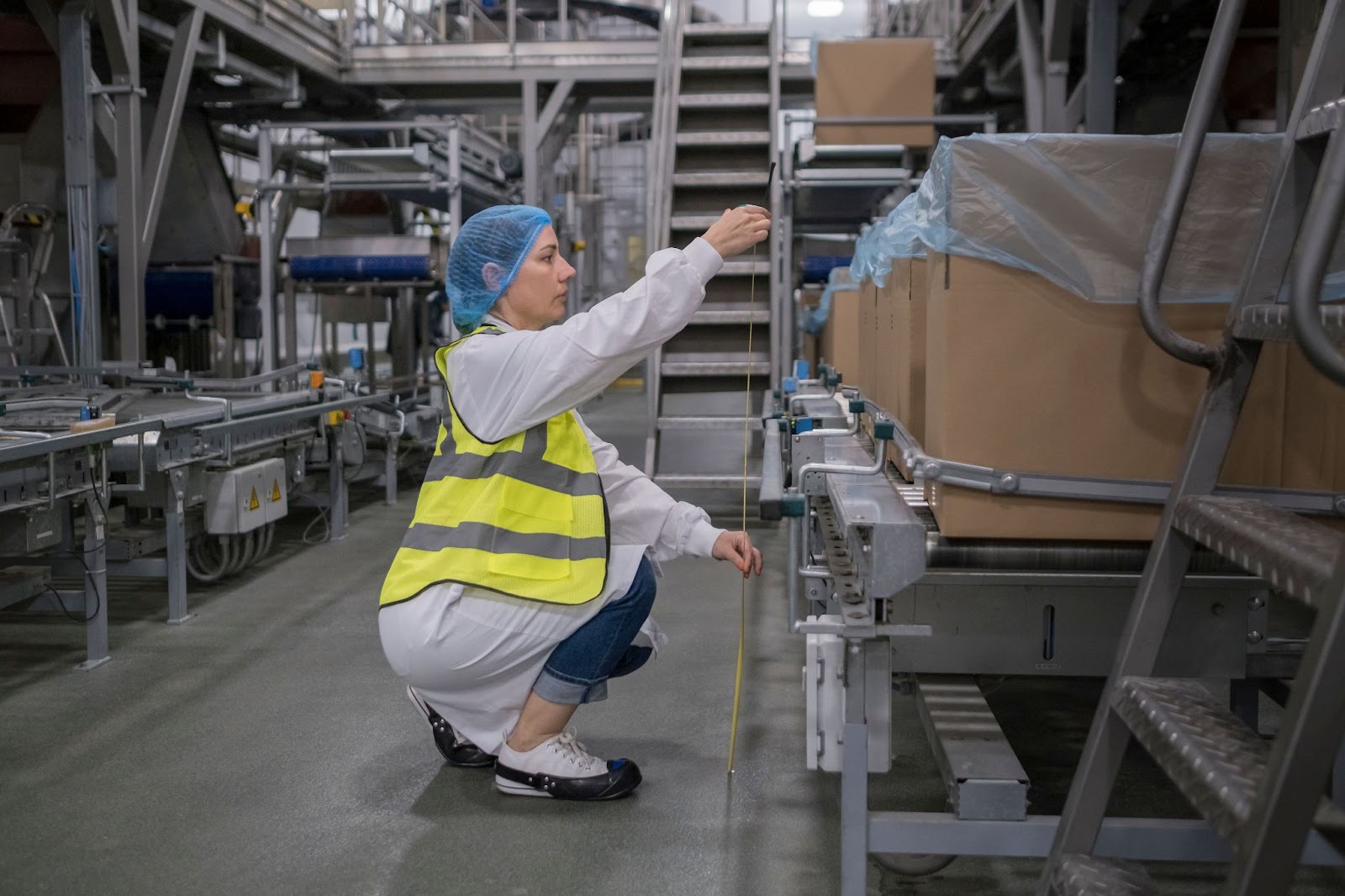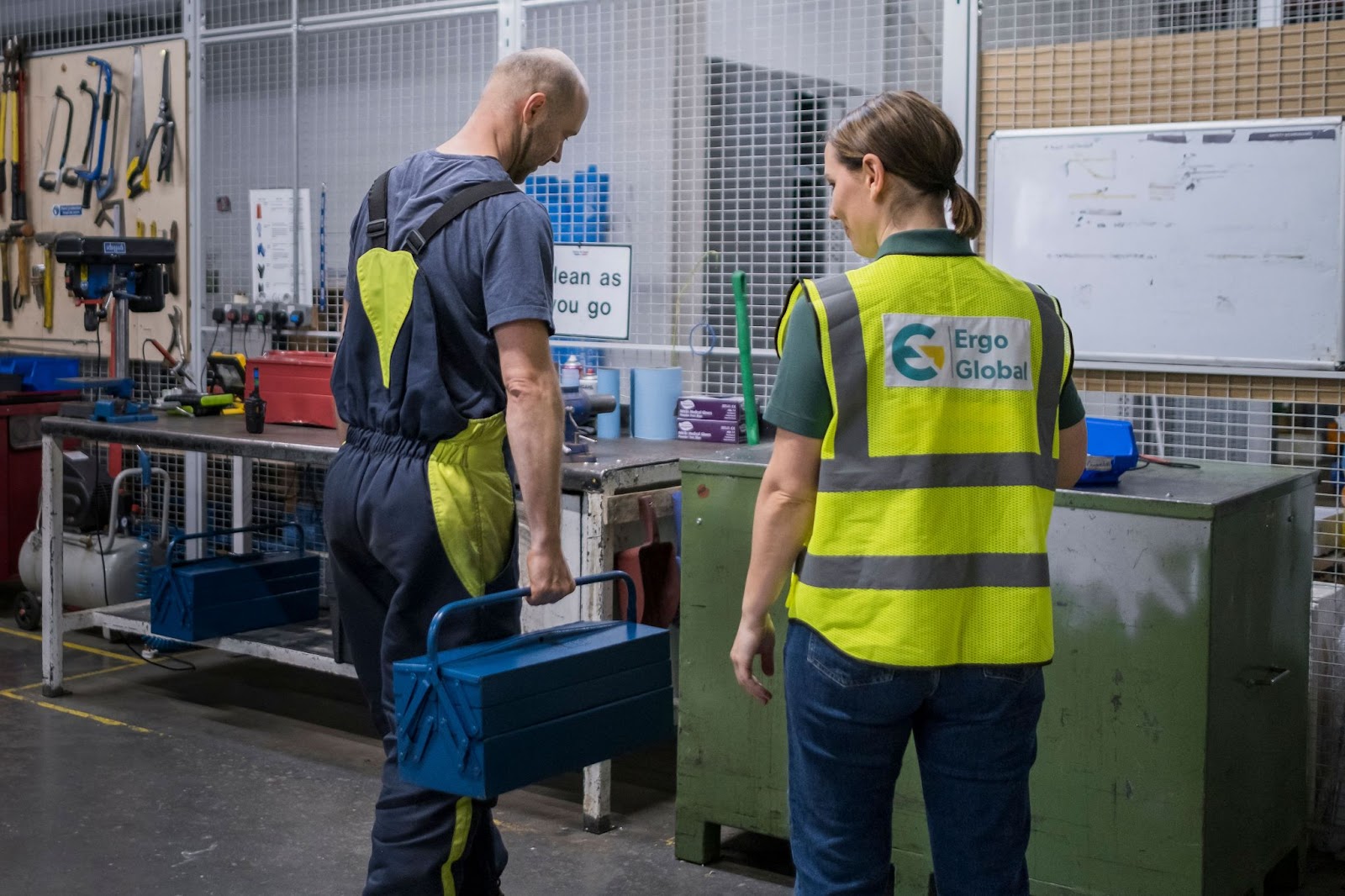Ergonomics, the science of designing workplaces to fit human needs, is transforming how businesses approach employee health and safety. By integrating ergonomically designed workstations, companies can significantly reduce workplace injuries, enhance employee well-being, and create safer, more efficient environments.
What Is Workplace Ergonomics?
Workplace ergonomics involves tailoring jobs to fit human capabilities, a key part of health and safety practices.
Ergonomics aims to lower injury risks with adjustments as simple as changing chair height or as complex as redesigning factory workflows. In an office, it might mean positioning a monitor to avoid neck strain. On a production line, it could involve adding lifting aids to protect backs. Either way, the focus remains on reducing harm, whether from repetitive tasks or prolonged discomfort.

This effort directly addresses musculoskeletal disorders (MSDs), such as carpal tunnel syndrome and back pain, which plague workplaces and lead to lost time. By tackling these physical threats, ergonomics also extends to mental strain and organizational hazards, offering a well-rounded safety boost.
Delaying these fixes invites accidents and health woes, but embracing them builds a workplace where safety thrives. Ergonomics is not just a priority but it’s a foundation for keeping employees well and operations smooth.
How Applying Ergonomics Can Improve Health and Safety in the Workplace
Poorly designed workspaces contribute to a range of issues, from musculoskeletal disorders (MSDs) to accidents and burnout, costing organizations billions annually in medical expenses, lost productivity, and employee turnover.
By addressing these risks through ergonomic design, businesses can safeguard their employees and reduce the financial burden of health-related costs.
Reducing Musculoskeletal Disorders (MSDs)
Musculoskeletal disorders (MSDs)—conditions like carpal tunnel syndrome, tendinitis, and chronic back pain—rank among the most prevalent workplace health issues. These injuries stem from repetitive motions, awkward postures, or prolonged static positions, often seen in tasks like typing, lifting, or assembly work.
In 2019, MSDs accounted for 32.1% of nonfatal workplace injuries requiring time off, with direct costs nearing $20 billion annually and total economic losses, including productivity declines, reaching $45–54 billion.
These conditions often stem from repetitive motions, awkward postures, or prolonged strain—issues ergonomics directly targets. By fostering neutral body positions and minimizing repetitive stress, ergonomic interventions transform how work is done. Adjustable chairs and desks, for instance, allow workers to align their spines naturally, easing pressure on joints and muscles.

Ergonomics tackles MSDs by redesigning work environments to minimize physical strain. Adjustable chairs with lumbar support, height-variable desks, and ergonomic keyboards allow workers to maintain neutral postures, reducing stress on muscles, joints, and tendons.
In manufacturing, lifting aids and tools that lessen force requirements protect against overexertion. Studies show that such interventions can cut MSD-related injuries by up to 50% in industrial settings, while office workers report a 40% drop in symptoms after adopting ergonomic setups. Workstation adjustments and training significantly reduce upper limb and neck issues further, with effects consistent across diverse workforces.
Beyond prevention, ergonomic solutions improve quality of life. Employees free from chronic pain can sustain focus and energy, avoiding the fatigue that often accompanies MSDs. This foundational benefit sets the stage for broader improvements, as a physically healthy workforce is better equipped to thrive in comfortable, supportive conditions.
Enhancing Physical Comfort and Mental Well-Being
Physical comfort is a cornerstone of workplace health, and its influence extends deeply into mental well-being.
Employees confined to poorly designed chairs, glaring screens, or cramped spaces often experience discomfort that erodes their focus and mood. Over time, this physical strain can escalate into stress, anxiety, or burnout, creating a cycle of declining health and productivity.
Ergonomic designs break this cycle by prioritizing comfort. Features like adjustable seating with proper lumbar support, anti-glare monitors, and workstations tailored to individual heights reduce physical fatigue and eye strain.
Research underscores the impact: comfortable employees report lower stress and higher engagement, while ergonomic workstations are linked to sharper mental clarity and reduced exhaustion. Workers who received ergonomic training and workstation adjustments experienced perceived stress reductions of up to 30% and job satisfaction improvements of around 10–20%.

This interplay between body and mind is critical. A worker free from back pain or headaches can concentrate better, collaborate more effectively, and approach tasks with greater resilience. In contrast, discomfort breeds distraction and frustration, undermining morale.
Ergonomics thus serves as a dual-purpose tool, enhancing physical health while fostering a positive psychological environment—a benefit that naturally leads to safer workplaces.
Boosting Productivity Through Efficiency
Ergonomics doesn’t stop at safety—it supercharges productivity by streamlining how tasks are performed. When workers are unshackled from pain and fatigue, their focus sharpens, and their efficiency soars.
With tools placed within easy reach or a workstation angled to minimize twisting—these tweaks eliminate wasted motion and accelerate workflows.
In a data entry firm, ergonomic redesigns slashed error rates by 20% and lifted output by 15%, proving that safety and performance go hand in hand.
Absenteeism also drops—by as much as 30% in ergonomic workplaces as healthier employees stay on the job. This synergy of comfort and efficiency turns ergonomics into a catalyst for both individual success and organizational gains.
Preventing Accidents and Injuries
Safety is a fundamental concern in any workplace, and ergonomics plays a pivotal role in reducing accidents and injuries beyond MSDs.
Hazards like cluttered layouts, complex machinery, or inadequate signage contribute to incidents such as falls, trips, and equipment mishaps. Falls and overexertion are often the leading causes of nonfatal workplace injuries, underscoring the need for preventive measures .
Ergonomic principles address these risks by creating intuitive, hazard-free environments. Non-slip flooring, color-coded controls, and unobstructed walkways minimize accident potential, while proper lighting reduces eye strain and missteps. In high-risk sectors like construction and healthcare, training in safe lifting techniques and ergonomic equipment use significantly reduces injury rates.
For example, a case study in a manufacturing facility demonstrated a 25% reduction in workplace incidents, including slips, trips, and falls, following ergonomic improvements such as better workstation layouts and tool accessibility. Likewise, well-designed workstations in industrial settings enhance safety by minimizing physical strain and reducing human error, creating safer and more efficient work environments.
Proactive ergonomic assessments amplify these gains. Regular evaluations, whether expert-led or employee-driven, usually identify risks like poorly placed tools or awkward layouts before they cause harm.
This preventive focus not only protects workers but also supports their ability to perform effectively, especially as workforce demographics evolve.
Supporting an Aging Workforce
The global workforce is aging, with projections indicating that by 2030, one in five Americans will be over 65. Older employees bring valuable experience but may face physical challenges like reduced flexibility, strength, or vision, increasing their vulnerability to injuries and fatigue. Ergonomics adapts workplaces to meet these needs, ensuring older workers remain safe and productive.
Tools requiring minimal force, such as lightweight scanners or power-assisted lifts, reduce strain, while magnifying screens and adjustable desks accommodate declining eyesight or mobility. For instance, a cashier with arthritis might use a seated station with ergonomic grips, preserving their efficiency without risking injury.

Research shows that such interventions can lower MSD risk in older workers by up to 40%, supporting their long-term health. These adaptations also promote inclusivity, retaining skilled employees who might otherwise retire early.
By addressing age-related challenges, ergonomics bridges generational gaps, maintaining a diverse, capable workforce. This stability, in turn, influences organizational culture, as long-tenured employees contribute to lower turnover and stronger safety practices.
Reducing Employee Turnover
Employee turnover disrupts continuity and incurs steep costs in recruitment and training. Ergonomics counters this by enhancing workplace satisfaction and signaling organizational care.
When workers see investments in their comfort and safety—through ergonomic furniture or tailored workflows—they feel valued, fostering loyalty and reducing the urge to leave.

Data supports this link: ergonomic programs can cut turnover by up to 87% in some settings, particularly in high-turnover fields like retail or warehousing. Another study found that employees in ergonomically optimized workplaces were 20% more satisfied and 15% less likely to seek new jobs, reflecting the morale boost from a supportive environment. This retention effect is especially potent when paired with safety improvements, as workers are more likely to stay where risks are minimized.
Lower turnover also reinforces health and safety indirectly. Experienced employees, familiar with protocols and ergonomic tools, uphold best practices, creating a self-sustaining culture of well-being.
This stability enhances efficiency, as a consistent workforce can operate with greater skill and coordination.
How to Make It Happen
Have questions about ergonomics or safety? Contact Ergo Global’s support team.
We’re ready to guide you toward a healthier, safer workplace.



